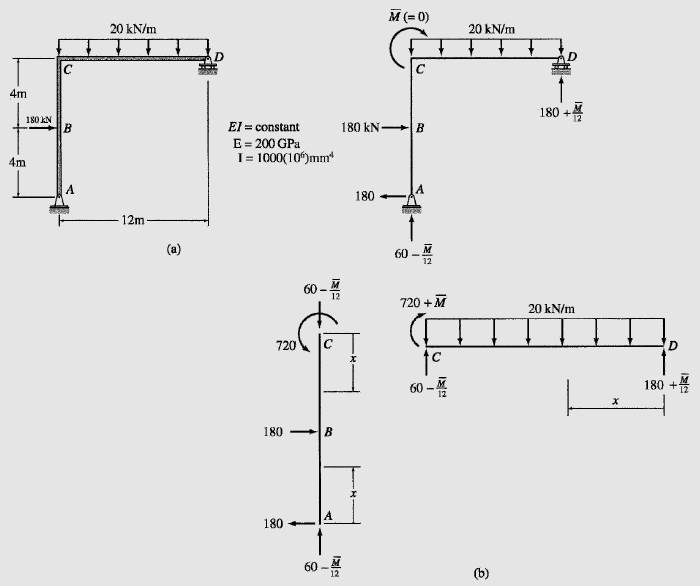Question 7.15: Determine the rotation of joint C of the frame shown in Fig....
Determine the rotation of joint C of the frame shown in Fig. 7.23(a) by Castigliano’s second theorem.

Learn more on how we answer questions.
This frame was previously analyzed by the virtual work method in Example 7.10.
No external couple is acting at joint C, where the rotation is desired, so we apply a fictitious couple \overline{M} (= 0) at C, as shown in Fig. 7.23(b). The x coordinates used for determining the bending moment equations for the three segments of the frame are also shown in Fig. 7.23(b), and the equations for M in terms of \overline{M} and ∂M/∂\overline{M} obtained for the three segments are tabulated in Table 7.12. The rotation of joint C of the frame can now be determined by setting \overline{M} = 0 in the equations for M and ∂M/∂\overline{M} and by applying the expression of Castigliano’s second theorem as given by Eq. (7.65):
θ = ∑∫(\frac{∂M}{∂\overline{M}}) \frac{M}{EI}dx (7.65)
θ_C = ∑∫(\frac{∂M}{∂\overline{M}}) \frac{M}{EI}dx= \int_{0}^{12}{(\frac{x}{12})(180x – 20 \frac{x^2}{2}) dx}
= \frac{4320 kN-m^2}{EI} = \frac{4320}{200(10^6)1000(10^{-6})} = 0.0216 rad
θ_C = 0.0216 rad ![]()
| TABLE 7.12 | ||||
| Segment | x Coordinate | M (kN-m) | \frac{∂M}{∂\overline{M}} (\frac{kN-m}{kN-m}) | |
| Origin | Limits (m) | |||
| AB | A | 0-4 | 180x | 0 |
| CB | C | 0-4 | 720 | 0 |
| DC | D | 0-12 | (180 + \frac{\overline{M}}{12})x – 20\frac{x^2}{2} | \frac{x}{12} |
